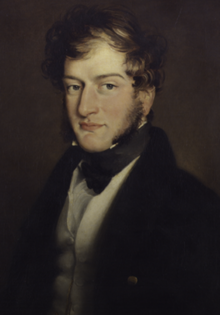William Jay (architect)
William Jay | |
|---|---|
 Jay, pictured around 1817 | |
| Born | 16 November 1792 Bath, England |
| Died | 17 April 1837 (aged 44) |
| Nationality | British |
| Occupation | Architect |
| Spouse | Louisa Coulson |
| Children | 3 |
| Parent | William Jay |
William Jay (16 November 1792[1] – 17 April 1837) was an architect. He designed several notable buildings, firstly in London, then in Savannah, Georgia, United States.
Early life
Jay was born in Bath, England, the second child and oldest son of William Jay Sr. He started working with his father as a stonemason,[2][3] but became a Congregationalist minister. In 1807, the younger William became an apprentice of the architect and surveyor David Riddall Roper.
Career

Jay's designs for Surrey Chapel Almshouses were exhibited at the Royal Academy in 1814. He designed Dr. Fletcher's Albion Chapel in London, laying the foundation stone the following year.
In December 1817,[4] he moved to the United States for four years, where he established as an architect in Savannah, Georgia. His American work includes the Bulloch–Habersham House, the Owens–Thomas House, the William Scarbrough House, Telfair Academy and the original 1818 Savannah Theatre.[5] The design of the now-demolished Archibald Bulloch House, which he designed, was later replicated in the Habersham Memorial Hall. It has been suggested that Jay also designed the Juliette Gordon Low House at the corner of Bull Street and Oglethorpe Avenue.[5]
Family
In 1827, Jay married Louisa Coulson of Henley-on-Thames. They had three children between 1829 and 1835; the oldest child, also William, died soon after the family's arrival in Mauritius at the age of six. Jay's widow and other two children returned to England after his death.[6]
Later life and death
When the economy of Georgia collapsed in 1822,[4] Jay returned to England and worked primarily in Cheltenham.[3] Later, he went bankrupt and, in 1836, moved with his family to the island of Mauritius, where he was an architect and civil engineer until his death in Port Louis in 1837, aged 44.[2]
Notable works
- Telfair Family Mansion, Savannah, Georgia
- William Scarborough House, Savannah, Georgia
- Savannah Theatre, Savannah, Georgia, in its original form
- 21 West Bay Street, Savannah, Georgia
References
- ^ Building Data Sheet, Historic Savannah Inventory, Anson Ward, card number 19
- ^ a b William Jay (c. 1792–1837), The New Georgia Encyclopaedia, published November 1, 2004. Retrieved 26 January 2012.
- ^ a b Bradbury, Oliver C. William Jay's English Works after 1822: Recent Discoveries, Architectural History: Journal of the Society of Architectural Historians of Great Britain, Volume 43, 2000 (archived on JTOR.org). Retrieved 26 January 2012.
- ^ a b "William Jay". New Georgia Encyclopedia. Retrieved 18 October 2023.
- ^ a b Dawers, Bill. "New book on architect William Jay has contemporary relevance". Savannah Morning News. Retrieved 18 October 2023.
- ^ Telfair.
Further reading
- "William Jay". Telfair Museums. Retrieved 27 June 2020.
- "Bill Dawers: New book on architect William Jay has contemporary relevance". savannahnow. Savannah Morning News. Retrieved 27 June 2020.
- William Jay: His Life and Architecture - GoSouthSavannah.com
- Classical Savannah: Fine & Decorative Arts, 1800–1840 - Page Talbott, Telfair Museum of Art (1995)




